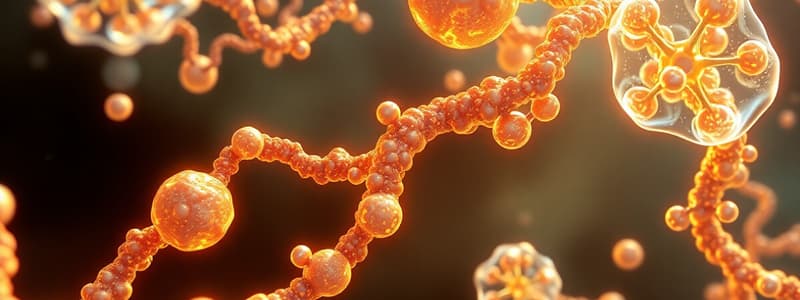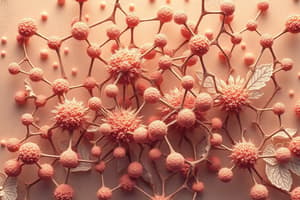Podcast
Questions and Answers
What is the caloric value of carbohydrates per gram?
What is the caloric value of carbohydrates per gram?
- 2 kcal
- 4 kcal (correct)
- 8 kcal
- 6 kcal
Which type of carbohydrate consists of only one sugar unit?
Which type of carbohydrate consists of only one sugar unit?
- Polysaccharides
- Oligosaccharides
- Disaccharides
- Monosaccharides (correct)
Which of the following carbohydrates is composed of two monosaccharide units?
Which of the following carbohydrates is composed of two monosaccharide units?
- Raffinose
- Sucrose (correct)
- Glycogen
- Cellulose
What role do carbohydrates play in DNA and RNA?
What role do carbohydrates play in DNA and RNA?
Which type of carbohydrate contains 3 to 10 monosaccharide units?
Which type of carbohydrate contains 3 to 10 monosaccharide units?
Flashcards
What is the primary function of carbohydrates?
What is the primary function of carbohydrates?
Carbohydrates are the primary source of energy for cells, providing 4 calories per gram.
What is a structural role of carbohydrates?
What is a structural role of carbohydrates?
Carbohydrates are essential structural components of cell membranes, forming glycoproteins and glycolipids, which are located on the exterior surface of cells.
What are monosaccharides?
What are monosaccharides?
Monosaccharides are the simplest form of carbohydrates, consisting of a single sugar molecule.
What are disaccharides?
What are disaccharides?
Signup and view all the flashcards
What are polysaccharides?
What are polysaccharides?
Signup and view all the flashcards
Study Notes
Carbohydrate Functions
- Carbohydrates are various substances like sugars, starches, fruits, vegetables, fiber, etc.
- They play essential roles in living organisms.
- Carbohydrates are a primary energy source for cells, with 4 kcal per gram.
- They are structural components of cell membranes.
- They are located on cell surfaces, bonded to proteins (glycoproteins) or lipids (glycolipids).
- They are structural components of DNA and RNA.
- They form the basis for nucleosides and nucleotides.
- They provide carbon skeletons in amino acids.
- They are crucial to biochemical processes and messenger molecules.
Carbohydrate Classification
- Carbohydrates are also known as "hydrates of carbon" with the general formula Cx(H₂O)y.
- They are the most abundant organic molecules in nature.
- They are categorized into four groups based on their chemical structures and hydrolysis products.
Types of Carbohydrates
- Monosaccharides: Single polyhydroxy aldehyde or ketone units (e.g., glucose, fructose).
- Disaccharides: Two monosaccharide units bonded together (e.g., sucrose).
- Oligosaccharides: 3-10 monosaccharide units (e.g., raffinose).
- Polysaccharides: Long chains of monosaccharides (e.g., cellulose, glycogen, starch). Polysaccharides are not sweet.
Studying That Suits You
Use AI to generate personalized quizzes and flashcards to suit your learning preferences.




